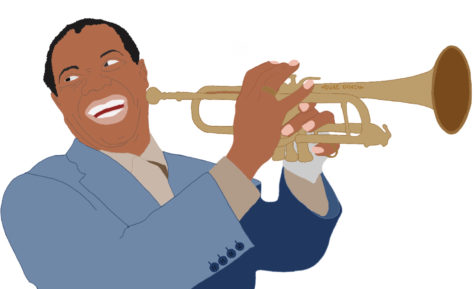‘Louis Armstrong’s Black and Blues’: Behind his legendary music
November 2, 2022
In New Orleans, Louis Armstrong is inescapable. As soon as you step off the plane, you enter an airport that bears his name and is filled with the sounds of his trumpet playing from speakers overhead. It’s comforting almost, to imagine Satchmo smiling from above as he welcomes people into his hometown. But at the same time, the exportation of, or perhaps indoctrination into, New Orleans culture through the near deification of the man lends itself to some rightful skepticism. Who was the man behind the trumpet, really?
In his bracing new documentary “Louis Armstrong’s Black and Blues,” filmmaker Sacha Jenkins attempts to answer this surprisingly complicated question. Jenkins satisfies music-lovers by allowing time for featured persons to harp on Armstrong’s musical pioneering, but he places the film’s focus on the man himself — a Black man living in a deeply segregated America, a man with real opinions and stories to tell.

Within the academic field of jazz studies, Louis Armstrong has long been understood as a somewhat divisive figure. On the one hand, he represents interracial brotherhood, the universality of jazz music and what musician Wynton Marsalis calls “transcendent joy.” But on the other hand, he was, for some, particularly those growing up during the civil rights movement, a vestige of the tradition of “Uncle Tomming,” complicit in the forces of oppression the movement fought to overcome.
Rather than adopting a particular stance on either side of this debate, the film embraces subjectivity and ambiguity, often relying on the reflections of Black male artists in relation to Armstrong’s significance. I was particularly struck by actor Ossie Davis’ recollection of coming across the jazz giant in a solitary moment, bearing on his face “the saddest, most heartbreaking expression [he] had ever seen,” which instantly transformed into that trademark grin as soon as Armstrong noticed him. This experience, an epiphany for Davis, caused him to “never laugh at Louis after that.” For in that smile, Davis didn’t see transcendent joy, but rather a method of survival adapted to a world far from wonderful.
But Jenkins also gives Armstrong some agency in the recontextualization of his story, a feature that in my eyes sets this documentary apart from its genre. I would argue that Louis Armstrong, who has been dead 50 years, is the true narrator of the film, as most of its information comes directly from the treasure trove of reel-to-reel recordings and letters that Armstrong curated and stored himself in his Queens residence.
On the tapes, we hear Armstrong recount tales of the mob-boss managers, hotel workers and police officers involved in the many injustices of his life, referring to them using expletives that startle when pronounced in the same voice that sang “Zipadeedoodah.” Luckily for us, Satchmo is more than a musician: he is a natural comedian. Stories of the antics of his youth provide the mostly pensive film with some humor and show that Armstrong’s cheerful appearance was not mere artifice.
Jenkins enlists the rapper Nas to read Armstrong’s letters, a choice as initially arresting as it is eventually appropriate. Nas’ powerful rasp hearkens at once to the characteristics of Armstrong’s natural voice and brings out the angrier undertones of his written word. One could imagine Nas as that piece of Armstrong that can now finally emerge, that spirit which gave life to, in Ossie Davis’ words, “a horn that could kill a man.”
Hip-hop seems to inspire the film in a broader sense as well; Jenkins opts for an unpretentious visual language and a structure inspired by musical sampling. While this aspect of the film’s identity granted it a freedom that documentaries often lack, it simultaneously caused similar points to be repeated a few too many times and made reconstructing a timeline of Armstrong’s life difficult.
Then again, relaying facts is not the film’s purpose, although I now have a much greater understanding of Armstrong’s life and legacy. It is a biography, arguably an autobiography, that invites the active participation of the viewer in working out the moral calculus of Armstrong’s decisions to act or not to act regarding the civil rights struggles of his day. Of course, the various questions the film raises are ultimately left as unresolved as a blues note. Its refusal to provide unambiguous interpretations allows it to fill up an important gap in an already extensive filmography of the subject.
“Louis Armstrong’s Black and Blues” is a valuable resource for anyone interested in learning more about the king of jazz. New Orleanians may find particular resonance with the film due to their particular immersion in the myth of the man. More than this, though, the film is a well-crafted portrait of a beautiful spirit, a man who represented the best in America even when it was at some of its worst.






















Leave a Comment